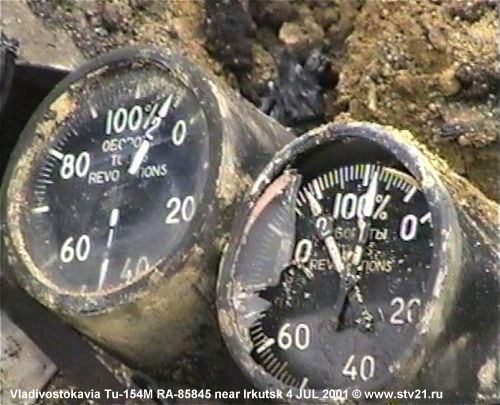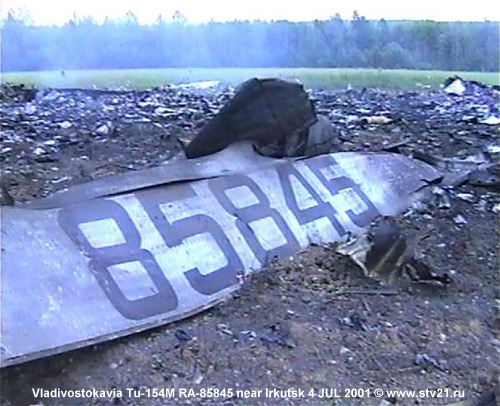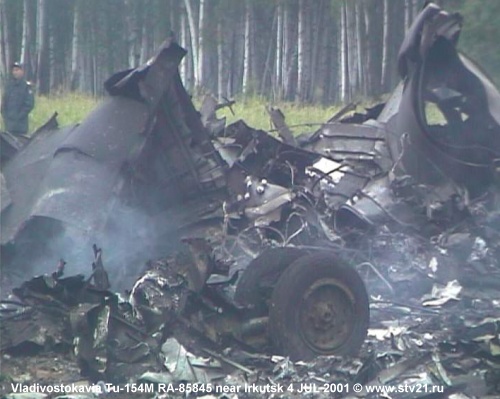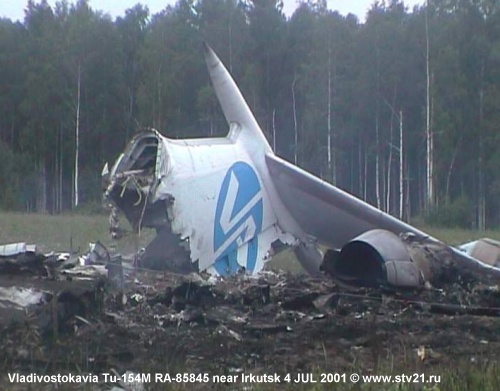
| Date: | Wednesday 4 July 2001 |
| Time: | 02:08 |
| Type: |  Tupolev Tu-154M |
| Owner/operator: | Vladivostokavia |
| Registration: | RA-85845 |
| MSN: | 86A735 |
| Year of manufacture: | 1986 |
| Total airframe hrs: | 20953 hours |
| Cycles: | 11387 flights |
| Engine model: | Soloviev D-30KU-154-II |
| Fatalities: | Fatalities: 145 / Occupants: 145 |
| Aircraft damage: | Destroyed, written off |
| Category: | Accident |
| Location: | near Burdakovka -
 Russia Russia
|
| Phase: | Approach |
| Nature: | Passenger - Scheduled |
| Departure airport: | Ekaterinburg-Koltsovo Airport (SVX/USSS) |
| Irkutsk Airport (IKT/UIII) | |
| Confidence Rating: |
Vladivostokavia Flight 352 operated on a flight from Ekaterinburg to Vladivostok with an intermediate stop at Irkutsk. The flight departed Ekaterinburg at 19:47 local time and climbed to the cruising altitude of 10,100 m. Some three hours after takeoff, at 01:50 local time, descent was initiated. The descent and approach into Irkutsk was flown by the first officer.
At 02:05 the crew reported at 2100 m, runway in sight. The airplane still had an airspeed of 540 km/h. The maximum speed at which the landing gear may be lowered was 400 km/h. At 02:06:56 the airplane level off at 900 m, the airspeed still being about 420 km/h. The first officer ordered the gear down and the speed further decreased to 395 km/h with engines at idle. When the gear was down and locked the airplane entered a left hand turn with a 20-23 degree bank. The airspeed further decreased to 365 km/h where the recommended speed was 370 km/h in this stage of the flight. Power was added slowly. This was only just sufficient for maintaining an altitude of 850 m at 355-360 km/h. At 02:07:46, while still in the left hand turn, the angle of attack increased to 16,5° because the autopilot attempted to maintain altitude with a decreasing speed. An aural warning then sounded, indicating a high angle of attack. The first officer attempted to correct this and by using the control column, he disconnected the autopilot. Because he deflected the control column to the left, the left bank increased trough the maximum permissible value of -30° to -44°, and then to -48°. With the nose pitched down the speed increased to 400 m.
The airplane entered a layer of clouds, so the crew did not have a possibility of observing of the natural horizon and the landmarks under these conditions at night.
The captain intervened and attempted to control the airplane. He alternately deflecting the steering wheel to the left and right. An intensive deflection of steering control to the right, caused a positive angular acceleration of +4,4°/sec2. The captain reacted by deflecting the steering wheel to the left again. The first officer now realizes that the airplane is in a severe left bank (-45°) and indicates that they should be rolling to the right.
Because of an increase in vertical descent rate (20 m/sec), one of the crew members pulled the control column. The airplane pitched up rapidly, entered a stall and a subsequent flat spin. The crew were unable to regain control. After spinning for 22 seconds, the aircraft slammed down on its belly, broke up and burned.
The cause of the accident were the erroneous actions of the crew:
When approaching the landing, the crew could not maintain the altitude mode of 850 meters when the aircraft was in the left turn at a speed less than recommended, which caused the autopilot to deflect the elevator to the height to fly, which increased the angle of attack.
With a 45° left bank the second pilot pulled the steering wheel toward him. As a result, the angle of attack increased. At a large angle of attack, much more thrust is required than the one used by the crew. As a result, the aircraft reached the overcritical angles of attack and began to lose the lift of the wing.
The abnormal situation continued to develop, after 10 seconds of delay with increasing engine thrust, controllability was lost. Incorrect actions of the commander of the crew (instinctive, contrary to instructions) only aggravated the situation and as a result the plane crashed.
Sources:
Location
Images:

photo (c) www.stv21.ru; near Burdakovka; 04 July 2001

photo (c) www.stv21.ru; near Burdakovka; 04 July 2001

photo (c) www.stv21.ru; near Burdakovka; 04 July 2001

photo (c) www.stv21.ru; near Burdakovka; 04 July 2001

photo (c) www.stv21.ru; near Burdakovka; 04 July 2001

photo (c) www.stv21.ru; near Burdakovka; 04 July 2001

photo (c) Werner Fischdick; Beijing-Capital Airport (PEK); 18 October 1996
Revision history:
| Date/time | Contributor | Updates |
|---|
The Aviation Safety Network is an exclusive service provided by:


 ©2024 Flight Safety Foundation
©2024 Flight Safety Foundation